To witness a rare annular-total solar eclipse, “umbraphiles” from around the world converged along a narrow path from western Atlantic to northern Kenya. They report many successes and some wild experiences.
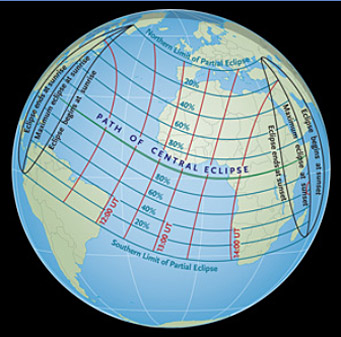
The solar eclipse on November 3, 2013, begins annular (at the far-left end of the central green line) but quickly becomes total as the Moon's umbra crosses the Atlantic Ocean, then central Africa. The eclipse is partial over a much wider region, as mapped by the grid. For your location, interpolate between the red lines to estimate the Universal Time of maximum eclipse, and between the blue lines for the fraction of the Sun's diameter that will be covered then. Click image for high-res version.
Sky & Telescope illustration / Fred Espenak
A total solar eclipse never fails to deliver the kind of otherworldly experience that is both beautiful in its delicacy and ominous in its abruptness. Little wonder, then, that people from around the world do whatever it takes to stand in the Moon’s shadow.
Such devotion was again evident during November 3rd’s eclipse, during which the Moon’s shadow traced out a ribbon of darkness some 8,500 miles (13,600 km) long but only 36 miles (58 km) across at its widest. Owing to Earth’s curvature, this intriguing event began as a barely annular eclipse in the western Atlantic Ocean that quickly transitioned to full totality before sweeping across central Africa.
At the western end, a group of intrepid observers chased the Moon’s shadow aboard a Falcon 900B aircraft that took off from Bermuda. Timing was critical, given the ultra-narrow shadow, but the team reports qualified success. “We agree this one is still too close to call,” comments participant Liz O’Mara. “Our possible choices for the seconds of totality seen are 1, 0, and less than 0.”
The longest duration, 99 seconds, would have been seen from a spot in the Atlantic southwest of Liberia. No one saw that, but a few ships were in the area. Passengers aboard the yacht SeaDream, positioned at 14.1° N, 31.8° W, dodged clouds to get mostly into the clear. “Fortunately, we got away from the really opaque high stuff,” reports Michael Gill, “and we were able to just see a watery-looking Sun with inner corona. No outer corona could be picked up.”
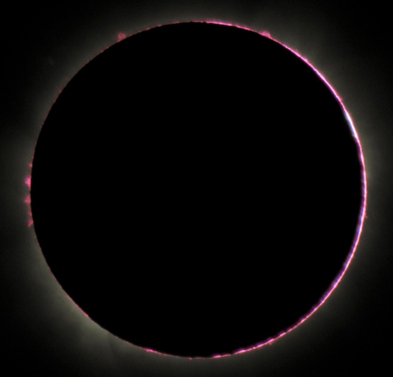
November 2013's total eclipse offered observers positioned near the end of the path a chance to view the Sun's crimson-hued chromosphere and prominences around most of the silhouetted disk. Alson Wong captured this view from Pokwero Village, Uganda. Click on the image for a larger version.
Alson Wong
A large group aboard the Corinthian, positioned at 5.7° N, 16.6° W, fared better, witnessing 90 seconds of totality in clear skies.
The Moon’s umbra raced eastward and reached the African coast at 13:51 Universal Time. Again, clear skies were the rule. Viewing from Port Gentil, near the centerline, Terry Cuttle was part of a small group of eclipse-chasers who saw totality perfectly for the first 25 seconds and then another 45 seconds though a very thin cloud.
Farther inland, Jay Pasachoff led a Williams College expedition that watched from near La Lope National Park in central Gabon. After a brief rainstorm, the sky cleared completely by the time of totality. Pasachoff reports that his 10-person team, funded by the National Geographic Society, obtained thousands of images and spectra.
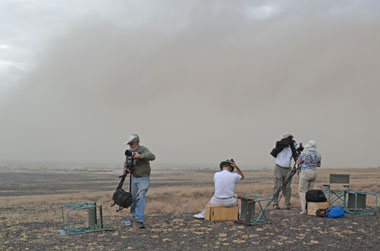
Observers at Lake Turkana in northern Kenya scrambled for cover during an intense sandstorm about an hour before totality.
Sky & Telescope: Kelly Beatty
Although the weather prospects across central Africa varied from so-so to downright risky, the run of clear skies continued along the eclipse path. Daniel Fischer and others had to scramble to avoid clouds near Pakwach, Uganda, and managed to glimpse 11 seconds of totality though thin clouds. As Fischer comments, “The view, while short, was breathtakingly beautiful, especially the swiftly developing colors in the sky.”
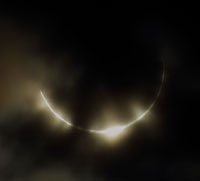
Eclipse-watchers on the eastern shore of Kenya's Lake Turkana managed only brief views of the eclipse's beginning and, as seen here, a cloud-filtered view of Baily's beads at third contact.
Jingbo Ni
Many eclipse-chasers had opted for the western and eastern shores of Lake Turkana in northern Kenya, which offered 11 seconds of totality and, statistically, some of the best chances of clear skies. But, as the old adage goes, “Climate is what you expect, weather is what you get.”
The sky was already partly cloudy and becoming more so when our Sky & Telescope/Spears Travel group arrived in chartered aircraft. About an hour before totality, a howling sandstorm and driving rain roared in from the east and enveloped our camp, blowing down everything except the small tent that housed the portable toilet. Fine dust got into everything — our eyes, throats, clothing, and of course our cameras and telescopes.
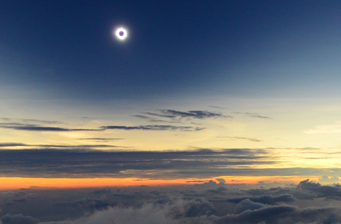
Having taken to the sky in chartered aircraft to avoid clouds over Lake Turkana, Kenya, 13 lucky observers were rewarded with stunning views of totality during the hybrid solar eclipse on November 3, 2013. Click here for a larger version.
Catalin Beldea
Then, right at totality, a tiny opening in the cloud deck allowed us to see the bottom half of the Sun. We got a nice show of Baily’s beads and a diamond ring before the Sun was again swallowed up.
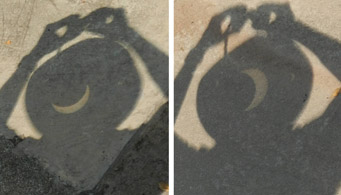
Two images, projected using binoculars and taken 30 minutes apart, show the partial solar eclipse as seen from Lagos, Nigeria.
Bob Kieckhefer
The threat of rain, and worse, forced a group of 13 led by Glenn Schneider to abandon their lakefront site and take to the skies about 40 minutes before totality. They headed west to outrun the storm and, making a final turn to cross the path, were rewarded with a clear view of the totally eclipsed Sun above the cloudtops. Schneider’s meticulous planning for any contingency had paid off.
A partial eclipse could be glimpsed throughout Africa. The skies were clear back in Nairobi, treating onlookers to a view of the Sun with 80% of its disk covered by the Moon. In Lagos, Nigeria, the skies cleared for the first time in several days.
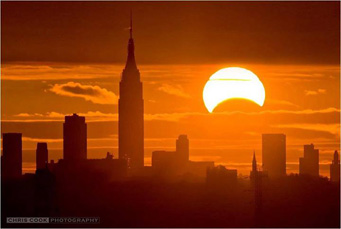
The partially eclipsed Sun rises behind the Empire State Building in New York City on the morning of November 3, 2013.
Unfortunately, the skies were cloudy along much of the East Coast of the U.S., where early risers had hoped to see up to half of the solar disk covered by the Moon at sunrise.
But not everybody had bad luck — some photos from New York showed a stunning partial eclipse peeking through the cloud deck. And, since there are no pesky clouds in outer space, the European Sun-watching satellite Proba 2 had an unobstructed view of a partial eclipse from its location in orbit.
 2
2









Comments
Frank Reed
November 4, 2013 at 1:55 pm
Fun with angles and photos. Comparing the Sun's angular size and the known scale of the Empire State Building and noting some foreground structures, my best estimate for the photographer's position is about 11-13 km WNW of the ESB. The foreground structures narrow things down considerably. I'm guessing the photo was taken from near the entrance to the James Zadroga Memorial Soccer Field in North Arlington, NJ close to lat/lon=40.78687,-74.12394 which is 12.4km from the Empire State Building. Can anyone confirm that location for the photographer? Or tell me how far off I am? The time was apparently close to 06:39 to 06:40 EST.
You must be logged in to post a comment.
indrek
November 6, 2013 at 1:43 pm
gabon coast in africa https://www.facebook.com/media/set/?set=a.10151714057592045.1073741828.694652044&type=1&l=b46d043d4e
You must be logged in to post a comment.
You must be logged in to post a comment.